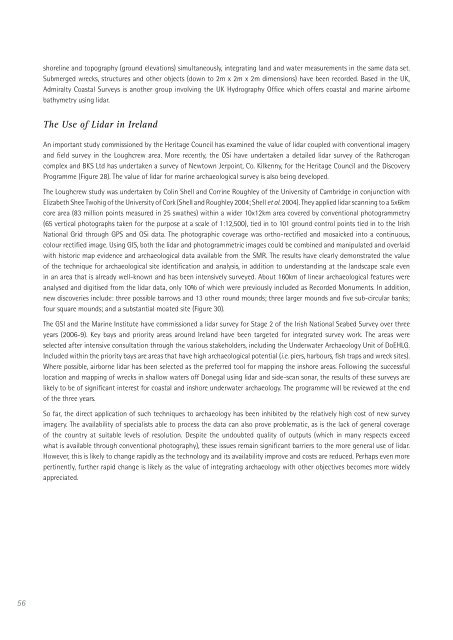Aerial Archaeology in Ireland - The Heritage Council
Aerial Archaeology in Ireland - The Heritage Council
Aerial Archaeology in Ireland - The Heritage Council
You also want an ePaper? Increase the reach of your titles
YUMPU automatically turns print PDFs into web optimized ePapers that Google loves.
56<br />
shorel<strong>in</strong>e and topography (ground elevations) simultaneously, <strong>in</strong>tegrat<strong>in</strong>g land and water measurements <strong>in</strong> the same data set.<br />
Submerged wrecks, structures and other objects (down to 2m x 2m x 2m dimensions) have been recorded. Based <strong>in</strong> the UK,<br />
Admiralty Coastal Surveys is another group <strong>in</strong>volv<strong>in</strong>g the UK Hydrography Office which offers coastal and mar<strong>in</strong>e airborne<br />
bathymetry us<strong>in</strong>g lidar.<br />
<strong>The</strong> Use of Lidar <strong>in</strong> <strong>Ireland</strong><br />
An important study commissioned by the <strong>Heritage</strong> <strong>Council</strong> has exam<strong>in</strong>ed the value of lidar coupled with conventional imagery<br />
and field survey <strong>in</strong> the Loughcrew area. More recently, the OSi have undertaken a detailed lidar survey of the Rathcrogan<br />
complex and BKS Ltd has undertaken a survey of Newtown Jerpo<strong>in</strong>t, Co. Kilkenny, for the <strong>Heritage</strong> <strong>Council</strong> and the Discovery<br />
Programme (Figure 28). <strong>The</strong> value of lidar for mar<strong>in</strong>e archaeological survey is also be<strong>in</strong>g developed.<br />
<strong>The</strong> Loughcrew study was undertaken by Col<strong>in</strong> Shell and Corr<strong>in</strong>e Roughley of the University of Cambridge <strong>in</strong> conjunction with<br />
Elizabeth Shee Twohig of the University of Cork (Shell and Roughley 2004; Shell et al. 2004). <strong>The</strong>y applied lidar scann<strong>in</strong>g to a 5x6km<br />
core area (83 million po<strong>in</strong>ts measured <strong>in</strong> 25 swathes) with<strong>in</strong> a wider 10x12km area covered by conventional photogrammetry<br />
(65 vertical photographs taken for the purpose at a scale of 1:12,500), tied <strong>in</strong> to 101 ground control po<strong>in</strong>ts tied <strong>in</strong> to the Irish<br />
National Grid through GPS and OSi data. <strong>The</strong> photographic coverage was ortho-rectified and mosaicked <strong>in</strong>to a cont<strong>in</strong>uous,<br />
colour rectified image. Us<strong>in</strong>g GIS, both the lidar and photogrammetric images could be comb<strong>in</strong>ed and manipulated and overlaid<br />
with historic map evidence and archaeological data available from the SMR. <strong>The</strong> results have clearly demonstrated the value<br />
of the technique for archaeological site identification and analysis, <strong>in</strong> addition to understand<strong>in</strong>g at the landscape scale even<br />
<strong>in</strong> an area that is already well-known and has been <strong>in</strong>tensively surveyed. About 160km of l<strong>in</strong>ear archaeological features were<br />
analysed and digitised from the lidar data, only 10% of which were previously <strong>in</strong>cluded as Recorded Monuments. In addition,<br />
new discoveries <strong>in</strong>clude: three possible barrows and 13 other round mounds; three larger mounds and five sub-circular banks;<br />
four square mounds; and a substantial moated site (Figure 30).<br />
<strong>The</strong> GSI and the Mar<strong>in</strong>e Institute have commissioned a lidar survey for Stage 2 of the Irish National Seabed Survey over three<br />
years (2006-9). Key bays and priority areas around <strong>Ireland</strong> have been targeted for <strong>in</strong>tegrated survey work. <strong>The</strong> areas were<br />
selected after <strong>in</strong>tensive consultation through the various stakeholders, <strong>in</strong>clud<strong>in</strong>g the Underwater <strong>Archaeology</strong> Unit of DoEHLG.<br />
Included with<strong>in</strong> the priority bays are areas that have high archaeological potential (i.e. piers, harbours, fish traps and wreck sites).<br />
Where possible, airborne lidar has been selected as the preferred tool for mapp<strong>in</strong>g the <strong>in</strong>shore areas. Follow<strong>in</strong>g the successful<br />
location and mapp<strong>in</strong>g of wrecks <strong>in</strong> shallow waters off Donegal us<strong>in</strong>g lidar and side-scan sonar, the results of these surveys are<br />
likely to be of significant <strong>in</strong>terest for coastal and <strong>in</strong>shore underwater archaeology. <strong>The</strong> programme will be reviewed at the end<br />
of the three years.<br />
So far, the direct application of such techniques to archaeology has been <strong>in</strong>hibited by the relatively high cost of new survey<br />
imagery. <strong>The</strong> availability of specialists able to process the data can also prove problematic, as is the lack of general coverage<br />
of the country at suitable levels of resolution. Despite the undoubted quality of outputs (which <strong>in</strong> many respects exceed<br />
what is available through conventional photography), these issues rema<strong>in</strong> significant barriers to the more general use of lidar.<br />
However, this is likely to change rapidly as the technology and its availability improve and costs are reduced. Perhaps even more<br />
pert<strong>in</strong>ently, further rapid change is likely as the value of <strong>in</strong>tegrat<strong>in</strong>g archaeology with other objectives becomes more widely<br />
appreciated.

















